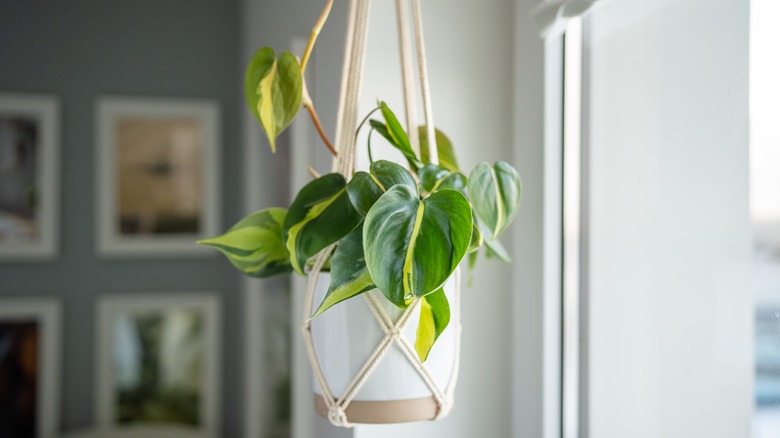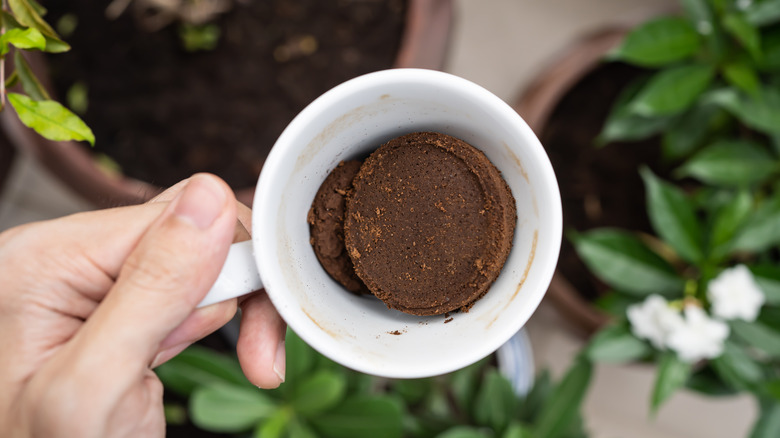The Common Kitchen Scraps That Will Help Your Philodendron Houseplant Thrive
Philodendrons are a popular plant among beginner and expert indoor plant enthusiasts alike. Not only are there so many different philodendron varieties that make for beautiful houseplants — from the coveted pink princess philodendron to the classic heartleaf philodendron — but philodendrons are also known for being easy to care for. If you struggle to keep plants alive, then a philodendron might just become your new green best friend.
One way to boost your philodendron's growth in a way that's also sustainable is by using leftover coffee grounds as fertilizer. Coffee grounds contain nitrogen — a crucial fertilizer component that plants use for photosynthesis. A philodendron that is low in nitrogen might grow slowly, droop, or even start to show yellow leaves. You can easily keep your philodendron happy and healthy at no extra cost by giving it your old coffee grounds. Here's how to make sure your philodendron makes the most out of your morning brew.
How to fertilize your philodendron with coffee grounds
The easiest way to give your indoor philodendron a little perk-me-up is by adding a small amount of coffee grounds directly to its soil. You can just sprinkle coffee grounds onto the top layer of soil, being careful not to layer them on too thick — one of the most important steps when using coffee grounds to fertilize your plants. Then, carefully use a fork or handheld gardening rake to disperse the coffee grounds throughout the soil; to avoid disturbing your philodendron's roots, keep your coffee grounds within the top few inches of soil.
Over-fertilizing your plant can cause just as many problems as under-fertilizing it, so it's important to not go overboard with your coffee grounds. A philodendron can be fertilized about once a month, though you can give them fertilizer a little more frequently during the spring and summer, as often as every two weeks.
If you've been applying coffee grounds regularly and are seeing yellow leaves, leaf burn, or are noticing that your philodendron isn't producing as many leaves as normal, stop fertilizing it; these are all signs you're over-fertilizing your plant. Unfortunately, over-fertilizing and under-fertilizing have many of the same symptoms. If you have not been fertilizing your philodendron and are noticing these kinds of symptoms, then starting a coffee ground routine is a great idea. If you've been applying coffee grounds to your philodendron and are seeing these symptoms when they weren't there before, you're probably over-fertilizing it.
Other tips and benefits of using coffee grounds on your philodendron
Believe it or not, you can also fertilize your philodendron with decaf coffee. That's because decaf coffee still contains the necessary nutrients — like nitrogen and potassium — that will help your plant thrive. Trust us, your philodendron doesn't need the caffeine!
When you're getting ready to fertilize your philodendron, make sure that you're using old coffee grounds. This ensures that the level of acidity in your coffee grounds has been diluted enough to be safe for your philodendron. High acidity can actually damage your plant and prevent it from absorbing the nutrients it needs; using old coffee grounds isn't just more sustainable but will also ensure that your plant can receive the benefits it needs from this fertilizing method.
Another bonus of applying coffee grounds directly to the soil is that they can actually have some antifungal properties, too. This means that used coffee grounds might be able to help prevent certain types of fungus from growing on your soil and potentially harming your philodendron. They could also help you prevent certain pests from landing on the soil of your philodendron, protecting it from pesky indoor houseplant critters. If you're curious to see what other plants can benefit from your morning brew, these are the 10 indoor houseplants you should fertilize with coffee grounds to help them thrive.


